Text
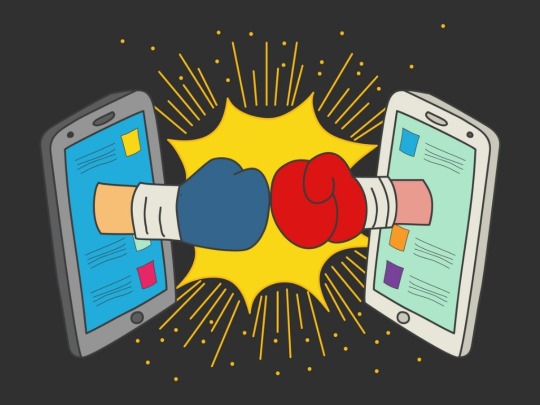
WEEK 10: DIGITAL CITIZENSHIP AND SOCIAL MEDIA CONFLICT
Social media has developed as a platform for many digital citizens to connect. It opened new environments so that people can share their thoughts, and beliefs about different topics. However, besides the bright side, social media also contains problems that are raised by itself. One of them is conflict, along with online harassment, which is growing at a fast pace, especially when there are controversial cases.
1. Why look at conflict?

These days, conflict on social media is a bulging problem. It refers to the intense movements, debates, and tensions created between users on various platforms. It includes the spread of information, contrasting viewpoints, or hostile activities which can result in misconceptions or conflict escalation. Social media has the power to shape perceptions, influence values, and mobilize users, impacting how conflicts manifest and evolve (Zeitzoff 2017). Examining conflict on social media is important due to its transformative impact on how conflicts unfold and evolve. It exposes the importance of power dynamics in digital citizenship, including control over resources, speech, platforms, and business interests. Many users aim to gain their power against their opinions, and viewpoints over many topics, especially controversial cases. Moreover, while digital communities can be seen to promote positive movements and relationships, they also face many bulging problems and complications. Power influence, misinformation, or online harassment, those communities are not immune to these drawbacks and can be easily affected if there is no proper social media governance.
2. Social media governance
The challenge of social media is planning what you want to post as opposed to randomly posting things and being sensitive to the fact that people take, [say], humor in different ways," says Katharine Brooks, EdD, executive director for personal and career development at Wake Forest University. These contents can be negative, cause controversies, or even conflicts between users. Therefore, the need for social media governance is essential to maintain the behaviors in the cyber environment.

Social media governance consists of the policies and guidelines that control the usage of social media platforms in communities, or society. It involves developing rules and frameworks that regulate the behaviors of its citizens, and organizations in the environment of social media. Facebook Community Standards, YouTube's Content Moderation, and the European Union's General Data Protection Regulation (GDPR) are remarkable examples of conducting guidelines on many platforms. In smaller communities, there are also governance models such as Redditquette, Subreddit-Specific Rules on many Subreddits, or Server-Specific Rules on many Discord servers. These guidelines are working to improve the etiquette of their community members by establishing more specific rules, limiting sensitive phrases, or even banning content that may not be offensive but is not relatable to the focused topic of the community. These movements help clean the environment of the platform and bring users a safe space for sharing related thoughts and opinions.
However, besides having good impacts on governing communities, these guidelines still have their downsides. On some occasions, they can missee clean contents and falsely accuse them as negative. Several governance systems are mainly controlled by AI, in their automatic abilities may not be as accurate as humans in some cases. Many positive contents consist of sensitive phrases, whether they have no intention to be offensive, and can still be detected as violations, while many negative contents can surpass the barrier and still appear on the platform. These contents vary in many forms such as misinformation, trolling, or online harassment, which takes a high percentage in many negative behaviors.

3. Online harassment
Online harassment refers to a broad spectrum of abusive behaviors enabled by technology platforms and used to target a specific user or users, including flaming (inflammatory language), doxing (the stealing of personal information), or public shaming (using social media sites to humiliate a person)… (Blackwell et al. 2017).
Although there is a long history of research on online misbehavior and community moderation, harassment and other types of violence continue to be common online. A Pew survey conducted in 2017 revealed that 66% of adult internet users have seen someone be harassed online, and 41% of users have personally experienced online harassment (Blackwell et al. 2017). Gender also plays a role in the types of harassment people are likely to encounter online. Overall, men are somewhat more likely than women to say they have experienced any form of harassment online (43% vs. 38%), but similar shares of men and women have faced more severe forms of this kind of abuse (Vogels 2021).

In real life, there have been many remarkable cases in which not an individual, but a group of community, was cyberbullied. Gamergate was an intense online harassment movement that began in 2014 in the gaming community. It was made up of a series of aggressive sexist assaults on women in the gaming industry, especially game creators, reviewers, and journalists. The case started from the personal life of game developer Zoë Quinn. Her ex-boyfriend created a blog post with false accusations regarding her relationships. This resulted in a rise of harassment and abuse aiming Quinn. She was threatened with doxxing, violence, and harmful web campaigns targeted at ruining her reputation.
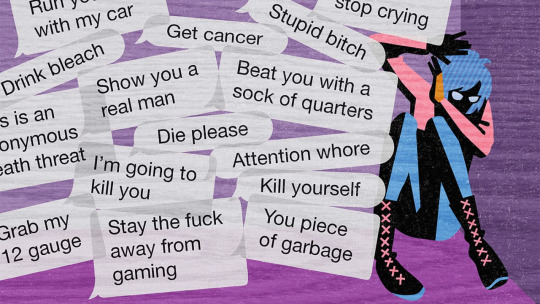
"You really can be judged harshly with one tweet," says Katharine Brooks, EdD, executive director for personal and career development at Wake Forest University (Robledo 2015). The cause of online harassment comes from many movements, from a simple, innocent tweet to a controversial activity of a celebrity. Historically, abusive behavior online has been relegated to fringe cases—“narcissists, psychopaths, and sadists (Buckels, Trapnell, and Paulhus 2014) who are either exceptions themselves, or inhabit atypical parts of the Internet.

When people face up with their problems, some of them may leverage the digital environment as a method to ease themselves and express their feelings and viewpoints. They may see debating or harassing others as their “fetish” to lash out their negative feelings and feel more power, which is also another reason for online harassment. Online harassment can also come from power dynamics when those with more influence or reputation utilize their power to target and harass others. This can apply to citizens who feel powerless against many aspects of their lives as they may try to gain control and become more powerful when abusing others on digital platforms. The anonymity feature in those environments is a functional way for individuals to engage in harassing behavior without fear of immediate consequences or accountability. These causes increase the amount of abusive behaviors in the cyber environment, making the situation more intense.
4. What can we do to reduce this situation?
To ease the amount of online harassment behaviors, legal activities can be made to control the behavior of citizens. They can be used to identify and criminalize extreme activities such as threats or cyberbullying. Along with that, appropriate laws and punishments should be published to apply to each behavior, especially criminal penalties. Therefore, legal solutions will deter others that online harassment is not acceptable and can lead to serious consequences. For instance, 18 U.S.C. § 2261A prohibits severe harassment or stalking using the internet, while 18 U.S.C. § 875 prohibits making threats across state lines, and 47 U.S.C. § 223 prohibits harassing or threatening messages across state lines (Federal Laws & Online Harassment 2021).

Despite legal movements from social media governments, there is still a lack to be full control of digital citizens' behaviors. Therefore, other actions to improve the awareness and behavior of digital citizens should also be imposed. Promoting awareness regarding internet harassment is essential. This includes educating people about responsible ethics, digital citizenship, and the negative effects of harassment. Citizens will behave more properly, respecting others’ differences and discussing in a peaceful environment. Many cases relating to cyberbullying or harassment will also be more detected as users are more aware of their responsibility in the digital environment. They may report violating cases to the managing tools of social media, where they will be more easily detected and punished. Keeping clean of the digital environment requires both the contribution from social media governance and the citizens themselves.
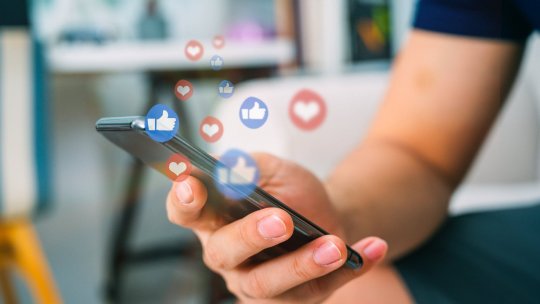
References:
1. Blackwell, L, Dimond, J, Schoenebeck, S & Lampe, C 2017, ‘Classification and Its Consequences for Online Harassment’, Proceedings of the ACM on Human-Computer Interaction, vol. 1, no. CSCW, pp. 1–19.
2. Buckels, EE, Trapnell, PD & Paulhus, DL 2014, ‘Trolls just want to have fun’, Personality and Individual Differences, vol. 67, pp. 97–102.
3. Federal Laws & Online Harassment 2021, Online Harassment Field Manual, viewed 25 March 2024, https://onlineharassmentfieldmanual.pen.org/federal-laws-online-harassment/.
4. Robledo, SJ 2015, ‘Navigating conflicts on social media’, https://www.apa.org, September, p. 26, viewed 25 March 2024, https://www.apa.org/gradpsych/2015/09/social-media.
5. Vogels, E 2021, The State of Online Harassment, 13 January, viewed 25 March 2024, https://www.pewresearch.org/internet/wp-content/uploads/sites/9/2021/01/PI_2021.01.13_Online-Harassment_FINAL-1.pdf.
6. Zeitzoff, T 2017, ‘How Social Media is Changing Conflict’, Journal of Conflict Resolution, vol. 61, no. 9, pp. 1970–1991.
0 notes
Text

WEEK 9: GAMING COMMUNITIES, SOCIAL GAMING AND LIVE STREAMING
1. History of video games
Video games are interactive digital games that are played on many platforms, such as smartphones, computers, or consoles. They mainly feature one or more players participating in a virtual environment, controlling characters to accomplish objectives, overcome challenges, and meet goals in the game.

The history of video games began in the 1950s - 1960s when programmers started creating basic games and simulations on early-aged minicomputers. A remarkable example of them is Spacewar!, which was designed by the students of MIT in 1962. The game depicts a simple space combat scenario, where two players control spaceships and engage the battle in a 2D space environment.
Thanks to SpaceWar! and other early-aged video games, the foundation for the industry of gaming had been laid. In 2005 and 2006, Microsoft’s Xbox 360, Sony’s PlayStation 3, and Nintendo’s Wii kicked off the modern age of high-definition gaming (Editors 2017). These days, video games are being more and more developed with modern technologies, 3D dimension environments, stunning graphics… Newer control systems and family-oriented games have made it common for many families to engage in video game play as a group. Online games have continued to develop, gaining unprecedented numbers of players (University of Minnesota Libraries Publishing 2016). The most remarkable of them are League of Legends, FC Online, Fortnite… With a huge number of players, high-resolution graphics, and competitive gameplay, they dominated most game markets in many countries and opened a new environment for gamers to show off their abilities.

2. The culture of gaming
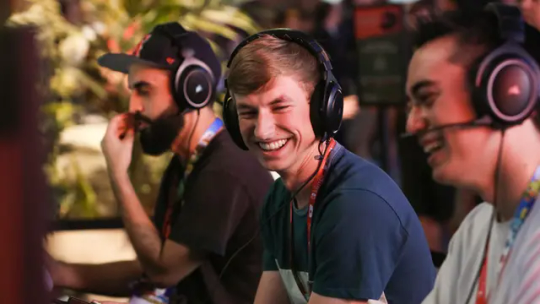
Since the gaming industry began to develop, it also formed the culture of playing video games. It consists of the popular attitudes, behaviors, and practices that surround gamers and their communities. One of the most popular stereotypes about gamers is that they are considered to be mainly young people, white or East-Asian, and predominantly males. According to the Entertainment Software Association’s 2018 recent report, 45% of gamers in the U.S. are female. However, among core gamers, males dominate, making the female statistic somewhat misleading (Fu n.d.). Sexism and inappropriate behavior towards females are commonplace. Players appear to conform to stereotypical masculine norms and tend to maintain a male-dominant hierarchy.

Besides the dominance of males in old stereotypes about video games, the culture of nerd and geek is also another remarkable stereotype. Gamers are mainly seen as nerdy, lazy, and unattractive. They are also considered not to have stable study or job occupations, most of the time focusing on video games. The view from the society to them is mainly negative as they are seen to have no beneficial contribution to the community. However, on the other hand, those people are highly welcomed in gaming communities, who share with them many similar interests and behaviors.
3. Gaming communities

Since the birth of video games, players have always been looking to find like-minded people. From the first pixel adventures to today’s multiplayer online worlds, gaming communities have played a huge role in transforming games from mere entertainment to true cultural phenomena (Games 2023). These communities mainly take place in online games environments or social media such as Steam Community, Discord, Reddit… A number of them can also bond together by performing real-life activities. There have been gaming events which are hosted to showcase technologies and connect gamers such as Gamescom, Taipei Game Show, DreamHack… In Vietnam, these occursions are becoming more popular as they can be hosted locally with a small number of gamers in local gaming centers or huge tournaments in arenas. Communities of reputable games such as Gunny, League of Legends, and FC Online are the main contributors to the shared environment. A number of them also take part in community movements such as MixiGaming. In 2020, the group donated about 200 million VND to build bridges for a remote mountainous village in Cao Bang province and used the residue funds to give bicycles to children with difficulties traveling to their schools. These activities improved the image of gaming communities in many people, influencing them to change their thoughts about gaming culture.

4. Live-streaming in gaming culture
The donations of MixiGaming mainly come from live streaming sessions of Do Mixi, a reputable gamer in Vietnam. He conducted live videos and publicized all the received money to maintain transparency of the fund. Live-streaming is also an attractive point not only for him but also for many gamers. Video game live streaming is a kind of real-time video social media that integrates traditional broadcasting and online gaming (Li, Wang & Liu 2020). In recent years, the online broadcast industry has developed rapidly with the emergence of various live-streaming platforms, such as Twitch, YouTube, Douyu, Huya, and so on. In 2016, Twitch and YouTube Gaming had more than 470 million regular visitor members in 2016 (more than 50% of gamers in the US, Europe, and Asia Pacific). In recent years, the market for this type of gaming media has even increased more sharply, making it an ideal market for many streamers. From these live-streaming sessions, communities are formed around them as the streamer attracts several viewers. They can make a great contribution to other content of the live streaming channels, whether to give suggestions for the next video or be on stage with the streamer. The phenomenon gave birth to many communities and improved the influence of gamers, making live streaming a lucrative market and developing the gaming industry as well.

References:
1. Editors, H com 2017, Video Game History, HISTORY, viewed 21 March 2024, https://www.history.com/topics/inventions/history-of-video-games#modern-age-of-gaming.
2. Fu, D n.d., A Look at Gaming Culture and Gaming Related Problems: From a Gamer’s Perspective, viewed 21 March 2024, https://smhp.psych.ucla.edu/pdfdocs/gaming.pdf.
3. Games, BG 2023, Gaming Communities: The Rise and Impact of Gaming Communities on the World of Video Games, Medium, viewed 21 March 2024, https://bggames.medium.com/gaming-communities-the-rise-and-impact-of-gaming-communities-on-the-world-of-video-games-1fec152f649f.
4. Li, Y, Wang, C & Liu, J 2020, ‘A Systematic Review of Literature on User Behavior in Video Game Live Streaming’, International Journal of Environmental Research and Public Health, vol. 17, no. 9, p. 3328.
5. University of Minnesota Libraries Publishing 2016, 10.2 The Evolution of Electronic Games, open.lib.umn.edu, University of Minnesota Libraries Publishing edition, 2016. This edition is adapted from a work originally produced in 2010 by a publisher who has requested that it not receive attribution.
0 notes
Text

WEEK 8: DIGITAL CITIZENSHIP AND SOFTWARE LITERACY - INSTAGRAM FILTERS
These days, selfies are becoming more and more popular in digital society as it is a way for many people to improve their social status, shake off appearance anxieties, and record memorable moments. Understanding the needs of users, social media developers keep launching new beauty augmented reality filters to keep “selfitis” on their platforms. This trend leads to a positive upgrade in beauty and appearance in digital society but also causes many psychological deviance and problems among selfie enthusiasts.
1. Augmented Reality (AR) Filters

According to LinkedIn, Augmented Reality is a cutting-edge technology that seamlessly blends digital 2D and 3D content with the real world, transforming either users’ appearance or environment and creating unique experiences and interactions. They are commonly applied to users’ faces – for example, adding “cool” apparel, improving their facial features, transforming one into a fictional creature, or overlaying ‘silly’ items (e.g. Taco hat) (Javornik et al. 2022). Alongside the rapid growth of smart devices, the popularity of these filters is increasing day to day. These days, in coffee shops, it is not difficult to see a group of “selfie enthusiast” holding their phone straight to the face and trying out various filters. Bhatt (2020) reports that 600 million people use AR filters each month on Instagram or Facebook and 76% of Snapchat users use them every day, making them one of the most attractive functions on those sites.
2. AR Filters in the example of a social media platform - Instagram
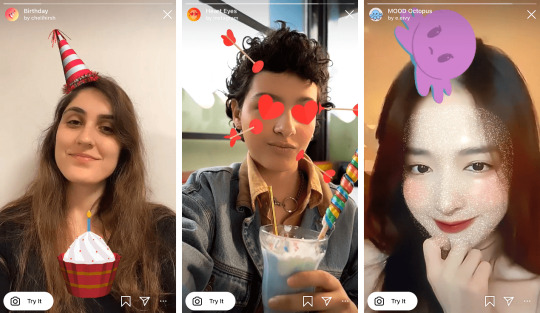
Since Instagram - one of the most popular social media, began adding face filters in 2017, this rapidly became a hit among users. In September 2020, Meta - the mother company owing Instagram, announced that over 600 million people had tried at least one of its AR features. Every month, it is reported that about 700 million users across Meta products access AR in some capacity (usually filters). The launch of these filters leads to an increase in the interest of many users as it is a method to increase self-image. However, it also causes many drawbacks. During the period from October 2019 to August 2020, Instagram had to ban some filters because of controversy about affecting users' mental health. Some of them, such as Plastica or Fix Me, are seen to be mimicking face surgery, which could passively affect their users’ well-being (Scott 2019).
3. Effects
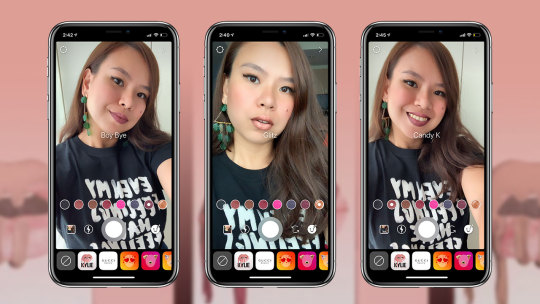
The impact of AR filters is controversial as they provide both many advantages and also drawbacks. On the bright side, these filters have provided users with a powerful tool for image enhancement. By enabling users to enhance features such as their eyes, cheeks, skin… AR filters have opened up a world of possibilities for individuals seeking to present themselves in a certain light (Kumar & Madhushree Nanda Agarwal 2023). Moreover, users can also create their own filters for public use, further expanding the potential impact of this technology. The ability to boost the picture allowed individuals to express themselves more openly and attractively, therefore encouraging creative communication and emotional responses between users.

However, on the dark side, AR filters are accused of encouraging unrealistic beauty standards and impacting users' self-image. It can alter face characteristics, body parts, or skin look, also causing unrealistic beauty standards. This can severely impact users' body image and self-esteem. Being constantly exposed to modified pictures might increase pressure to meet those unrealistic standards, leading to feelings of dissatisfaction with one's looks. Moreover, overreliance on filters may distort the distinction between virtual and real-world looks, possibly rendering it difficult to accept oneself without digital embellishments. The real confidence of those people will be highly affected as in reality, they “do not look the same as on their Instagram photos”.

4. Future & Solutions
The future of AR filters is promising, with continuous growth and expanding market potential. By the end of 2025, it is projected that nearly 75% of the global population and almost all smartphone users will be frequent AR users. AR filters are not just a "plaything," but are becoming more recognized as an actual tool that can be utilized in daily life. 76% of people expect to use AR filters as a tool, and 94% of consumers who interact with products that have AR experiences have a higher conversion rate (Sofija 2022).
In September 2017, IKEA introduced IKEA Place, an augmented reality app that allows customers to digitally check out their furniture. This is carried out simply by scanning the area, therefore improving the accuracy of the shopping experience for customers. AR filters are then soon to be used not only for entertainment on social media but also in many aspects of our lives.

The development of AR filters is promising with their modern technologies. However, they can also have another side if not leveraged carefully. They can bring us image enhancements, while they can cause unrealistic beauty standards and models. Therefore, having good control of those filters is a mission of many social media creators and producers. Understanding the purposes of filters, as well as their benefits and drawbacks before launching is needed to leverage filters. Creators should also need to have a good selection of filters, in which to choose whether they are entertaining and beneficial to users, instead of perpetuating unrealistic changes on the body. Finally, certain education for social media users about filters and self-image can be conducted more. This method will improve the self-awareness and knowledge of users when they use filters. They will be able to realize and focus on leveraging AR filters for healthy entertainment, rather than being to the side of dissatisfaction, and expectations of unreality standards.

References:
1. Javornik, A, Marder, B, Barhorst, JB, McLean, G, Rogers, Y, Marshall, P & Warlop, L 2022, ‘“What lies behind the filter?” Uncovering the motivations for using augmented reality (AR) face filters on social media and their effect on well-being’, Computers in Human Behavior, vol. 128, no. 107126, p. 107126, viewed 2 March 2024, https://reader.elsevier.com/reader/sd/pii/S0747563221004490?token=C2FCB5A5DF589848E787953D5759B7990EBCED72E6360E2BDA180ED67E63FA10D50C03C6E45357DEA822281F2161C099&originRegion=eu-west-1&originCreation=20220107091932.
2. Kumar, H & Madhushree Nanda Agarwal 2023, ‘Filtering the reality: Exploring the dark and bright sides of augmented reality–based filters on social media’, Australian Journal of Management, SAGE Publishing, pp. 1–21.
3. Scott, D 2019, Instagram has banned a load of its most popular filters, Cosmopolitan, viewed 2 March 2024, https://www.cosmopolitan.com/uk/body/health/a29572762/instagram-ban-filters-plastic-surgery/.
4. Sofija, E 2022, What are augmented reality (AR) filters and how are they transforming the way consumers engage with brands?, www.linkedin.com, viewed 3 March 2024, https://www.linkedin.com/pulse/what-augmented-reality-ar-filters-how-transforming-way-emma-sofija/.
0 notes
Text

WEEK 7: BODY MODIFICATION ON SOCIAL MEDIA
In recent time, body modification has been a hot topic of sharings and discussions on media platforms. Body modification is the intentional modifying of the human body for aesthetic, cultural, religious, or personal purposes. It entails creating permanent or semi-permanent modifications to one's physique using a variety of techniques. According to (Rolle & Galliot 2022), any individual or collective action to intentionally change all or part of the body
can be termed “body modifications.” On social media, content relating to body transformation is becoming more and more popular. Most celebrities take advantage of their ability of visibility and aesthetic labor based on their journey of body modification. Those activities attracted many supporters to follow by and take attempts to adjust their body, which caused many controversies about its impacts, especially on public health.
1. Visibility labor

Visibility labor is the work individuals do when they self-posture and curate their self-presentations to be noticeable and positively prominent among followers and fans (Abidin 2016). This entails participating in measures that promote visibility and attract attention, such as social media presence, influencer marketing, and online self-promotion. On social media, visibility has become synonymous with acquiring status and
perceived influence with an attentive audience. Individuals with a big number of supporters and interactions on social media can be regarded as popular or influential. This view is based on the belief that having a huge following signifies a degree of significance, legitimacy, and influence.
2. Aesthetic labor
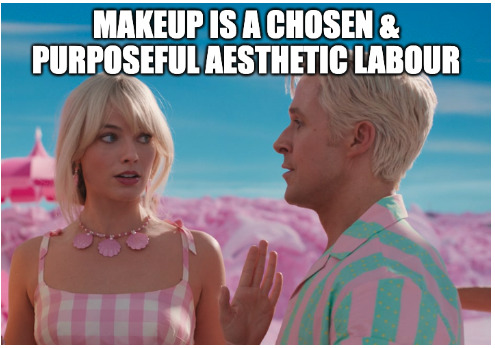
Aesthetic labor is the practice of screening, managing, and controlling workers based on their physical appearance (Mears 2014). In this field, employees are hired and instructed to convey pleasant personas and attractive looks. Aesthetic labor entails not just looking good but also “looking good and sounding right” (Warhurst & Nickson 2020). Individuals are supposed to not only present themselves visually appealingly, but also to exhibit specific behaviors, attitudes, and communication styles that are deemed proper or desirable in a given environment. They aim to the goal of showcasing an appealing image that corresponds to societal standards and the demands of the business itself. This has created popular aesthetic templates, which became the model framework for many users to follow by.
3. Aesthetic templates
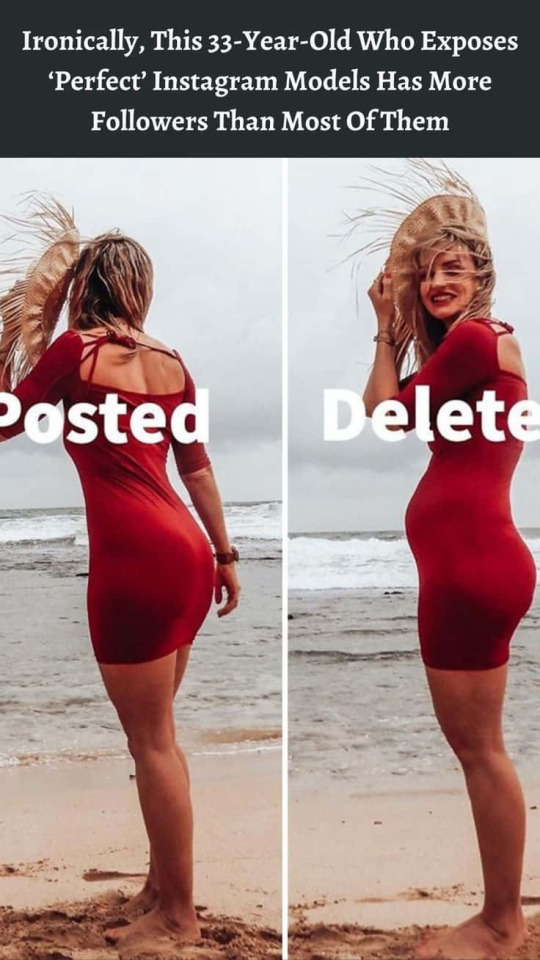

Aesthetic templates refer to pre-designed layouts or visual frameworks that are used to create a cohesive and visually appealing aesthetic for various purposes. On social media, especially popular sites such as Instagram, individuals frequently layout their online presence to reflect a particular aesthetic, which includes their physical appearance. This might include uploading photographs or films that focus on certain elements of their body, such as fitness, fashion, or attractiveness, in both for femininity and masculinity

On the femininity side, many reputable “Instagramers” make efforts to follow the pornification template such as enhanced features or emphasis on femininity, focusing on parts such as buttocks, waist, lips,… Other sections such as skin tones, poses are also emphasized in order to strengthen the “quality of femininity” in those products
In contrast to the aesthetic template of femininity, masculinity focus on showcasing body models such as hair, muscles, beards… The act of performing activities portraying dominance, athleticism or strength is also increased such as exercising, swimming, jogging… It also enhanced features in the same way as women such as jawline, belly, muscle…


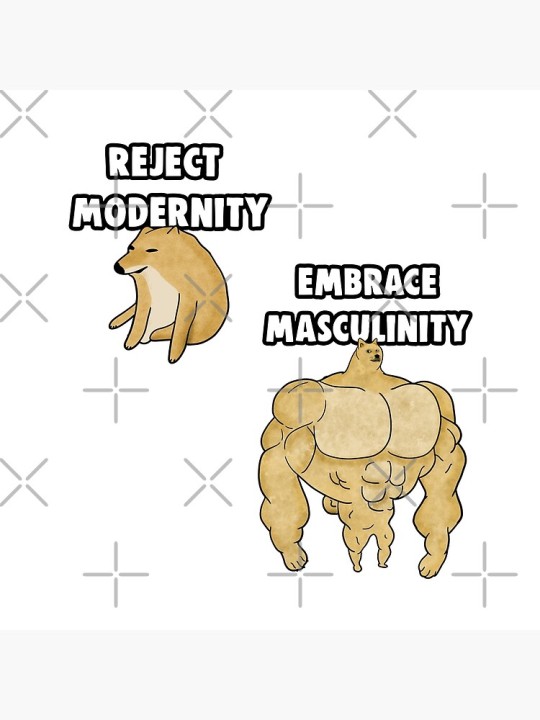
4. Body image crisis
A body image crisis is defined as a period of severe dissatisfaction anxiety, or negative thoughts regarding one's physique and appearance. It is characterized by a strong obsession and unhappiness with one's physical appearance, which can have a detrimental influence on general self-esteem and well-being. Moreover, individuals who are dissatisfied with their body typically describe a discrepancy between their subjective perception of their body and their ideal body image (Lindsay.Capozzi 2022). They may experience feelings of inadequacy, self-consciousness, and comparison to societal beauty standards.
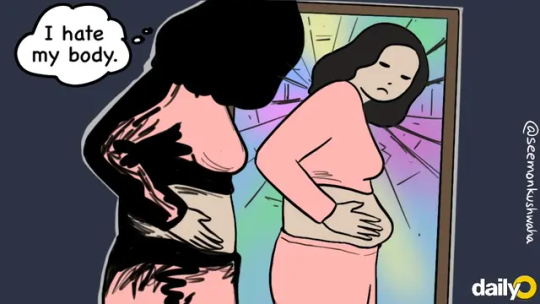
There are many factors affect how a person thinks about their body and body modification on social media is one of them. Dobson, Sarah & Robards (2018) warn of the power commercial social media platforms hold in their ability to monitor and control identities. Public ‘health campaigns’ that promote aesthetic templates may promote body image ideals that are unachievable and potentially unhealthy (physically and socially). It may also lead to continual comparisons with others, as users frequently display their highlight reels and choose to share their greatest moments. This can result in feelings of insecurity, low self-esteem, and the conviction that one's own physique or look does not compare to others.
5. Solution


To control the crisis, greater regulation of public health campaigns by online influencers is demanded. They should be focusing on real educational purposes rather than self-promotion. Social media users should also shape the environment on sites better with positive thoughts and societal ideas. They are the factors that can have the power to shape the societal norms of body modification.
References:
1. Abidin, C 2016, ‘Visibility labour: Engaging with Influencers’ fashion brands and #OOTD advertorial campaigns on Instagram’, Media International Australia, vol. 161, no. 1, pp. 86–100, viewed 5 March 2024, https://journals.sagepub.com/doi/10.1177/1329878X16665177.
2. Dobson, A, Carah, N & Robards, BJ 2018, Digital Intimate Publics and Social Media: Towards Theorising Public Lives on Private Platforms, research.monash.edu, Palgrave Macmillan, pp. 3–27, viewed 6 March 2024, https://research.monash.edu/en/publications/digital-intimate-publics-and-social-media-towards-theorising-publ.
3. Lindsay.Capozzi 2022, Body Dissatisfaction, Body Image Disturbance, Body Dysmorphia: A Primer for Providers, Caregivers and Media, policylab.chop.edu, viewed 6 March 2024, https://policylab.chop.edu/blog/body-dissatisfaction-body-image-disturbance-body-dysmorphia-primer-providers-caregivers-and.
4. Mears, A 2014, ‘Aesthetic Labor for the Sociologies of Work, Gender, and Beauty’, Sociology Compass, vol. 8, no. 12, pp. 1330–1343.
5. Rolle, V & Galliot, S 2022, ‘Body Modification’, The International Encyclopedia of Anthropology, pp. 1–8, viewed 24 April 2023, https://hal.science/hal-03899255/file/BM-V1.pdf.
Warhurst, C & Nickson, D 2020, Aesthetic Labour, SAGE.
0 notes
Text
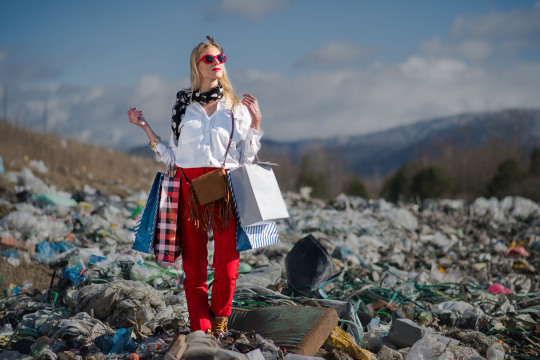
WEEK 6: SOCIAL MEDIA INFLUENCERS AND THE SLOW FASHION MOVEMENT
1. Fast fashion
In recent times, along with the rapid development and the demand for a “fast-food” like style of clothes, cheap and convenient, fast fashion is becoming more and more popular. Fast fashion is a business model that focuses on the production of garments in bulk, and as quickly as possible, in response to current trends, according to Dr. Preeti Arya, an assistant professor of textile development and marketing at the Fashion Institute of Technology in New York (Nicioli 2023). The term was initially used in a New York Times article in 1989 when Zara's first shop opened in the United States. According to the Times, the clothes were expected to have a design created from an idea to the final product in only 15 days, with reasonable prices and convenience for customers.

In general, fast fashion is developed based on luxurious showcases from many celebrities and designers, in many fashion runways of New York, Paris, Milan… Reputable brands such as Zara, H&M, or Mango replicate those trends as they appear in real-time to create new, desirable styles weekly, if not daily. They can provide massive amounts of clothing and can ensure that customers never tire of inventory (Stanton 2023). The objective is to get these designs into the hands of customers while the clothing is still at its peak popularity and all-too-low costs. Buyers can have a feeling of dressing in the same style as their admired celebrities like they are on the real fashion runway at a reasonable price.
2. Impacts of “instant noodle” fashion styles on the environment

In recent years, the fashion industry has received abundant criticism over its limited consideration of social and environmental issues, placing the non-financial costs of
fashion on the global public agenda (Niinimäki et al. 2020). According to an analysis by Business Insider, fashion production comprises 10% of total global carbon emissions, as much as the European Union. It dries up water sources and pollutes rivers and streams, while 85% of all textiles go to dumps each year (Maiti 2024). Even washing clothes releases 500,000 tons of microfibres into the ocean each year, the equivalent of 50 billion plastic bottles. Fiber production is also considered one of the main contributors to the industry’s global pollution impacts. The report also found that fiber production has the highest influence on freshwater withdrawal (water diverted or extracted from a surface water or groundwater source) and ecosystem quality caused by cotton agriculture. In 2030, the UN predicted that emissions from textile production itself are expected to increase by 60%.
3. "Slow fashion - slow food - slow digestion"

On the opposite end of the spectrum from the fast fashion production model, Kate Fletcher (2007) founded the slow fashion movement by drawing inspiration from the “slow food” movement, which emphasizes responsibility in food production and consumption. Companies that emphasize more sustainable practices make up the slow fashion movement, prizing craftsmanship, good stewardship, and quality products (Brewer 2019). Slow fashion is an approach to fashion that prioritizes sustainability, ethical principles, and quality over quantity. It emphasizes quality over quantity, ethical manufacture, sustainable materials, local production, and transparency.
4. Effects of slow fashion on the environment

Slow fashion promotes sustainable techniques and ethical working conditions. In opposite to quick fashion, it prioritizes quality and durability while advocating for both nature and people. Slow fashion promotes eco-friendly materials, minimizes waste, reduces carbon emissions, and supports ethical production processes. It also guarantees excellent manufacturing, extending the life of the garment or material. A rising number of farms and organizations favor the slow-fashion trend. One such example is the Better Cotton Initiative, which specifies principles and practices for sustainable production, while several more groups give resources and knowledge to modern farmers. By promoting mindful consumption and responsible production practices, slow fashion aims to create a more sustainable and ethical fashion industry that values craftsmanship, durability, and social responsibility.
References:
1. Brewer, MK 2019, ‘Slow Fashion in a Fast Fashion World: Promoting Sustainability and Responsibility’, Laws, vol. 8, no. 4, p. 24.
2. Fletcher, K 2007, Slow Fashion, The Ecologist, viewed 24 February 2024, https://theecologist.org/2007/jun/01/slow-fashion.
3. Maiti, R 2024, Fast Fashion and Its Environmental Impact, Earth.org, Earth.org, viewed 24 February 2024, https://earth.org/fast-fashions-detrimental-effect-on-the-environment/.
4. Nicioli, AM, Taylor 2023, What is fast fashion, and why is it so controversial?, CNN, viewed 24 February 2024, https://edition.cnn.com/style/what-is-fast-fashion-sustainable-fashion/index.html.
5. Niinimäki, K, Peters, G, Dahlbo, H, Perry, P, Rissanen, T & Gwilt, A 2020, ‘The environmental price of fast fashion’, Nature Reviews Earth & Environment, vol. 1, no. 4, pp. 189–200.
6. Stanton, A 2023, What Is Fast Fashion, Anyway?, The Good Trade, viewed 24 February 2024, https://www.thegoodtrade.com/features/what-is-fast-fashion/.
1 note
·
View note
Text
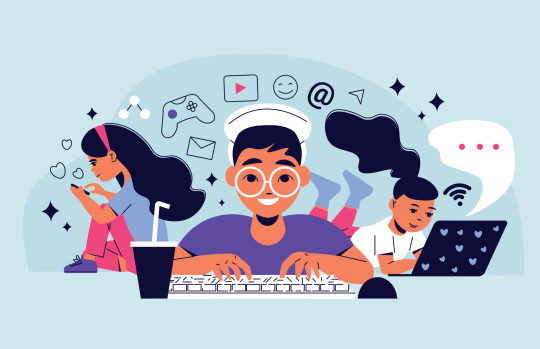
WEEK 5: DIGITAL CITIZENSHIP AND PLATFORMIZATION
1. Digital citizenship

Citizenship is a familiar concept to most people as it refers to the legal rights and duties of individuals attached to nationality under domestic law. A digital citizen is someone who, through the development of a broad range of competencies, can actively, positively, and responsibly engage in offline communities, whether local, national, or global (Richardson & Milovidov 2022). This concept applies the same as digital citizenship, in which it relates more to the rights and the duties of actions on digital platforms. Digital citizenship is the ability to navigate our digital environments in a way that's safe and responsible and to actively and respectfully engage in these spaces (Media Smarts 2022). In recent times, in the era of rapid media development, further understandings and applications of digital citizenship are more conducted. The Black Lives Matter movement enhanced its messages by effectively using social media, and the COVID-19 pandemic has also accelerated the need to understand digital citizenship profoundly, particularly emphasizing its effects on marginalized and oppressed people (Choi & Cristol 2021). Digital citizens were influenced to behave and act in a better manner in digital environments, in which their activities may affect movements in real society.
2. Platformisation

Platformisation is the process by which digital platforms affect, shape, or modify many elements of economic, social, or cultural activity. It refers to the growth of platforms and their growing influence in numerous areas of the economy and society. Platformisation works through the penetration of digital platforms into different economic sectors and spheres of life, leading to the reorganization of cultural practices and imaginations around these platforms. This process involves the intertwining of institutional changes with shifting cultural practices, and it is influenced by power relations among platform operators, end-users, and complements (Poell, Nieborg & van Dijck 2019). Contributing to the act of platformisation, digital platforms are the main factors as they are online intermediaries that facilitate the exchange of goods, services, or information between users. For example, e-commerce platforms (Amazon or Alibaba), improve trade, and the exchange of goods, ride-sharing platforms such as Grab, and Uber help grow transportation the most popular social media platforms (Facebook, Instagram, Twitter), which encourage the flow of delivery information between digital citizens.
3. Digital Citizenship and Political Engagement
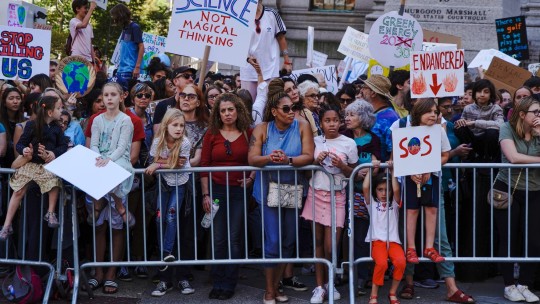
Political engagement and digital citizenship are closely related concepts in the digital era. Digital citizenship is defined as the responsible, ethical, and active use of digital technology and platforms, whereas political engagement is the participation and involvement of individuals in political processes and activities. When combined, they symbolize the various ways in which people may utilize digital platforms to engage in political debate, express their ideas, and participate in democratic processes. This combination operates in several ways:
Access to Information: Digital platforms offer users unlimited access to a wide range of information, such as news, political conversations, and policy debates. Digital citizens may search for information from a variety of sources, verify assertions, and remain up to date on political problems and events.
Political Expression and Participation: Digital platforms enable people to express their political beliefs, exchange thoughts, and engage in debates with others. Social media platforms, online forums, and blogging sites enable digital citizens to express their opinions, participate in public discussions, and interact with others who share their interests.
Online Activism and Mobilization: Digital platforms have proven useful in supporting online activism and mobilization. Hashtags, online petitions, crowdfunding campaigns, and social media movements allow people to raise awareness, advocate for causes, and rally support for political and social concerns.
Political Campaigning and Elections: Digital citizenship has revolutionized political campaigns and elections. Candidates and political parties rely on Internet media for voter outreach, fundraising, and communication. During election cycles, digital people may interact with campaigns, learn about candidates, and participate in online political conversations.
References:
1. Choi, M & Cristol, D 2021, ‘Digital Citizenship with Intersectionality Lens: Towards Participatory Democracy Driven Digital Citizenship Education’, Theory Into Practice, vol. 60, no. 4, pp. 361–370.
2. Media Smarts 2022, What is Digital Citizenship?, MediaSmarts, viewed 4 February 2024, https://mediasmarts.ca/digital-media-literacy/general-information/digital-media-literacy-fundamentals/what-digital-citizenship.
3. Poell, T, Nieborg, D & van Dijck, J 2019, ‘Platformisation’, Internet Policy Review, vol. 8, no. 4.
4. Richardson, J & Milovidov, E 2022, 2022 Edition of the Digital citizenship education handbook, Digital Citizenship Education (DCE), Council of Europe, viewed 4 February 2024, https://www.coe.int/en/web/digital-citizenship-education/-/2022-edition-of-the-digital-citizenship-education-handbook.
1 note
·
View note
Text

WEEK 4: DIGITAL COMMUNITIES AND FANDOM - REALITY TV
1. Public sphere
The public sphere, a concept that has evolved with the changing dynamics of society, represents a space where individuals come together to engage in open, democratic discourse on matters of common interest and concern. It is seen as a domain of social life where public opinion can be formed (Habermas, 1991, 398). Researchers envision the digital public sphere as a communicative sphere provided or supported by online or social media from websites to social network sites, weblogs, and micro-blogs – where participation is open and freely available to everybody interested, where matters of common concern can be discussed, and where proceedings are visible to all (Schäfer 2015).

2. Digital publics - an example of #AUSPOL
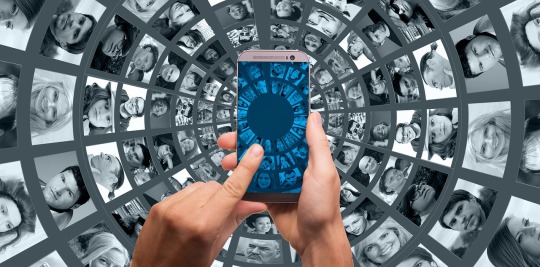
Digital publics form around shared interests, issues, and identities. They develop as digital and social media users create, publish, share, and engage with news, media, and journalism; participate in political debates; and express their everyday cultural interests and identities (Centre n.d.) An example in the context of Australia is #AUSPOL - a commonly used shorthand term that refers to Australian politics. The phrase is frequently used on social media sites as well as forums to debate and engage in discussions about Australian political topics, decisions, elections, and the general state of politics in Australia.
3. Reality TV

Reality television is a genre of programming that purports to show the unscripted actions of everyday people, rather than prepared dialogue delivered by actors (Albudaiwi 2018). From the mid-1990s forward, an increasing number of such television (TV) shows were available and have often dominated ratings. It is characterized by non-fictional content that follows the lives, experiences, competitions, or challenges of individuals or groups. Reality TV shows typically aim to provide entertainment, drama, and a glimpse into the lives and experiences of the participants. These shows include a variety of forms and topics such as talent competitions, dating shows, survival challenges, and documentary-style series. A few famous examples that can be seen in the region of Australia such as MasterChef Australia, The Block, Shark Tank Australia, Lego Masters…
4. Reality TV “creates” public

Reality TV can foster public or communities of viewers that engage in debates, exchange ideas, and build connections related to the show. These publics can exist online and offline, with viewers gathering to debate the show's competitors, plots, and outcomes. Reality television is a genre that is designed to elicit talk and shared opinions... not only in terms of judging the participants’ behaviors but also by speculating on the authenticity of what they are watching. This talk is not only found in homes, workplaces, and schools, but also proliferates online in forums, web comments, blogs, vlogs, and social media (Deller 2019). Discussions may focus on the participants' conduct, the show's editing or production decisions, and the program's ramifications or societal influence. These debates can go beyond the story itself, touching on larger societal themes or trends highlighted in the show. The show's conflicts, dramatic moments, or unexpected conclusions may become public conversation subjects, attracting attention from a larger audience and stimulating public debate.
References:
Albudaiwi, D 2018, ‘The SAGE encyclopedia of communication research methods’, The SAGE Encyclopedia of Communication Research Methods, vol. 4, no. 1.
Centre, QDMR n.d., Digital Publics, QUT Digital Media Research Centre, viewed 3 February 2024, https://research.qut.edu.au/dmrc/programs/digital-publics/.
CommGap n.d., The Public Sphere | Communication for governance and accountability program, viewed 3 February 2024, https://assets.publishing.service.gov.uk/media/57a08b45e5274a27b2000a69/PubSphereweb.pdf.
Deller, RA 2020, Reality television: the television phenomenon that changed the world, Emerald Publishing, Bingley, England.
Schäfer, M 2015, DIGITAL PUBLIC SPHERE, viewed 3 February 2024, https://www.academia.edu/download/41075853/Schafer__MS_-_Digital_Public_Sphere.pdf.
1 note
·
View note
Text
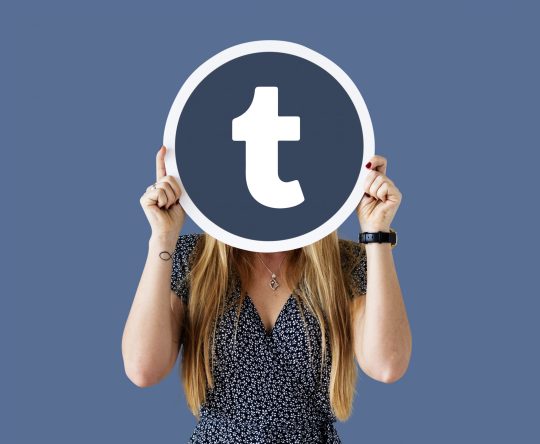
WEEK 3: HOW DOES TUMBLR FUNCTION AS A DIGITAL COMMUNITY?
1. Tumblr - a social media platform with surprising statistics
These days, social media users may be very familiar with platforms such as Facebook, Instagram, or TikTok with huge numbers of users and interactions. However, there is another digital community that not every one of those users already knows, which is Tumblr. Tumblr is a microblogging and social networking platform that allows users to post and share multimedia content. Founded by David Karp in 2007, it gained popularity for its unique blend of blogging and social features.

Compared with the popularity of other competitors such as Facebook, Instagram, or TikTok, many people may think that Tumblr will need more competent growth. However, the statistics of this social media site may surprise: Tumblr is ranked the number 10 social media site in Australia. According to Civic and Social Media News 2023, the platform acquires 3.7 million users, which outrages a few competitors such as TikTok 1.1 million and Reddit 110,000 users, thanks to the platform’s unique affordances.
2. Tumblr’s abilities and affordances:

Tumblr’s blog-like function allows account-holders to use the platform to create diaries of their daily lives, to post different types of information that inspire them, as well as to live about events as they happen or about TV shows as they are aired (Jo Dixon 2024). The platform also enables users to leverage the site’s anonymity, hashtagging, and relatively public or reduced surveillance. These functions contributed largely to the experience of “Tumblrers” as they can share their diaries and emotions publicly but anonymously without the fear of being spotted.
3. Digital community - a popular term in the digital era nowadays
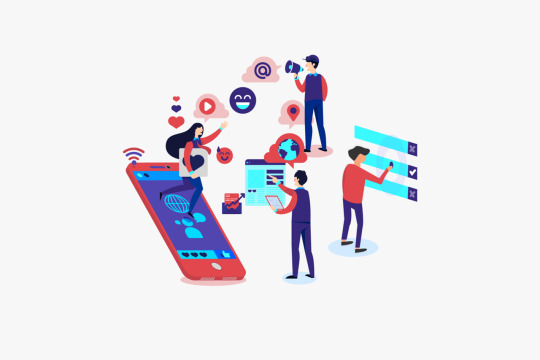
According to Indeed, An online community is a group of people with shared interests or a shared purpose who use the internet to connect. Groups on social media, members of online gaming platforms or support communities for software offerings all represent examples of online communities. Digital communities form around specific interests, hobbies, or goals. Members join these communities to connect with like-minded individuals, share information, seek advice, and collaborate on related projects.
4. Tumblr - a model of digital community

From the functions that Tumblr enables users to perform, it can be seen that the platform works as a digital community that allows users to connect, engage, and join groups based on common interests, identities, or artistic activities in several ways:
Blogging and Content Sharing: Tumblr allows users to build their own blogs and share a variety of content types, including text entries, photos, quotations, audio, and video. Users can share their ideas, creativity, and passions through postings, which are discoverable and interactable by the rest of the community.
Reblogging and Interaction: Reblogging is one of Tumblr's core features, allowing users to share content from other users' blogs on their own. This feature promotes content discovery and a feeling of community by allowing users to interact with and contribute to content published by others. Users may also interact with postings by leaving comments, like them, and sending direct messages, which helps encourage conversations and relationships within the community.
Personalization and Online Identity: Tumblr enables users to personalize the appearance of their blogs, which creates a distinct online identity and personal image. Users can showcase their personality through the style, layout, and content of their blogs, attracting like-minded others and adding to the community's general diversity and depth.
References:
1. Indeed Editorial Team 2022, FAQ: What Is an Online Community and Why Are They Important?, Indeed, viewed 1 February 2024, https://www.indeed.com/career-advice/career-development/online-community.
2. Jo Dixon, S 2024, Tumblr - Statistics & Facts, Statista, viewed 31 January 2024, https://www.statista.com/topics/2463/tumblr/#topicOverview.
2 notes
·
View notes